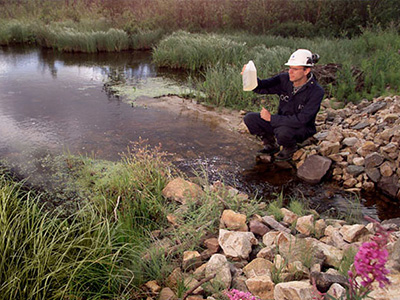Case Study
Athabasca Basin Water Monitoring

In the Athabasca region of northern Saskatchewan, maintaining the current high quality of water is of great importance to the local communities who continue to use the area for traditional purposes. The region is a downstream receiving environment from our northern Saskatchewan operations and, as a result, one of our greatest challenges is not only ensuring the quality standards of the water, but communicating the extent of the internal and independent water monitoring programs which verify those standards.
Some of the busiest people at our uranium operations in northern Saskatchewan are the environmental technicians and laboratory workers who gather and analyze samples to ensure the health and safety of people and local environments.
Sampling is a constant activity at the operations, and one reason why we are so confident in the reports we provide to regulators. “This ongoing sampling and laboratory testing allows us to say with confidence that the treated water from our mines and mills meets the limits established in our provincial and federal operating licences,” says Desmond Natomagan, an intermediate environmental technician at Key Lake who is also from northern Saskatchewan.
In addition to our own laboratory testing, we also send out a large number of samples to independent testing at laboratories like Saskatchewan Research Council in Saskatoon. The analysis from this testing confirms all elements in the treated water the operations discharge to the environment are well below the regulatory limits set for them.
Laboratory tests are just one of the tools used in monitoring. At the Key Lake operation, for example, the mill does not discharge directly to the environment but pumps treated water to a series of holding ponds prior to release. If the samples taken from a particular holding pond do not meet specifications, that water is returned to the mill for further treatment. Only when a treated water pond meets specifications through sampling and laboratory testing is it released into the receiving environment.
As well, a number of samples are taken from different locations in the downstream receiving environment. This type of monitoring demonstrates Saskatchewan’s uranium operations are fully compliant with all of the applicable provincial and federal regulations, including the Metal Mining Effluent Regulations (MMER) set by Environment Canada.
We also support independent environmental monitoring near the communities of the Athabasca Basin. One of these is the Athabasca environmental monitoring program that began in 2000, whose work is directed by the Athabasca Working group (AWG), a group made up of local community members that provides a forum to discuss issues related to uranium mining.
This program samples water, air and sediments near the communities and also gathers tissue from fish and animals that are traditionally harvested by local people. The samples are collected with the help of residents and the community members also decide where the samples should be collected.
Scientists from independent laboratories in Saskatchewan and the United States test the samples for a number of parameters found in the receiving environment. A northern Saskatchewan-owned company – Canada North Environmental Services – reports the results directly to the Athabasca communities. To date, the testing has shown no environmental effects from the present day uranium mining operations.
We also support another independent program that builds on community sampling and adds a strong technical aspect. The Eastern Athabasca Regional Monitoring Program (EARMP) was initiated in 2011 under the Province of Saskatchewan’s Boreal Watershed Initiative. A primary goal is to assess the ecological integrity of Saskatchewan’s northern watersheds in order to address potential environmental concerns and to identify sustainable management practices in the region.
Ryan Froess, a project manager and northern community coordinator with CanNorth oversees the program and says it’s designed to complement the other monitoring programs currently taking place in northern Saskatchewan. He says it’s gone a long way to helping put people’s minds at ease.
“We are doing a lot more sampling, including barren-ground caribou, moose, fish, berries and other country and wild foods,” says Froess. “We are able to say the water and food are healthy and good for you and will continue to be – that kind of reassurance goes a long way.”
Froess and his team make regular community visits and provide full access to all the results of their sampling online and through an annual report.
